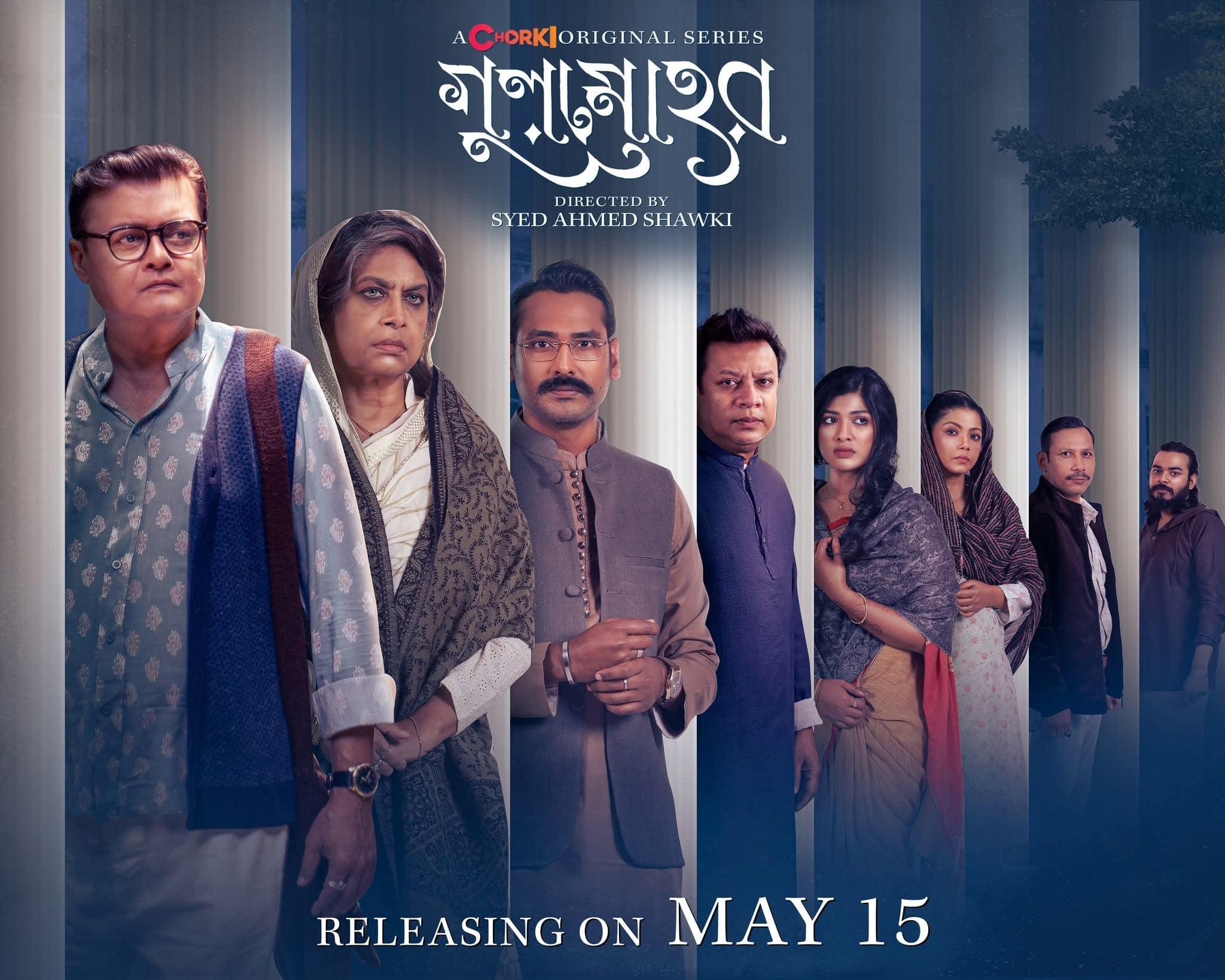
A review of Gulmohor (2025)
The story of Gulmohor begins where many stories usually end: at a funeral.
The most powerful man of Ayenarhat, Rahmat Talukder, is being laid to rest. But even in death, he receives no peace. The townspeople show up not to mourn but to condemn. Though wealthy and influential, the Talukder name is one stained by land grabbing and generational injustice – a name that inspires resentment, not reverence.
So starts this eight-episode miniseries, directed by Syed Ahmed Shawki, which premiered in May on Chorki, an OTT platform known for bold storytelling. At its heart, Gulmohor is not just a mystery or family drama; it’s a slow-burning exploration of generational trauma, moral collapse, and the corrosive power of greed.
Following Rahmat Talukder’s death, his four children return to their ancestral mansion, the grand yet decaying Gulmohor. Despite the shared grief, cracks soon appear.quickly as tensions rise over property, inheritance, and old wounds. Each character carries their own baggage, with different lives, different perspectives, and different truths. These conflicting personal histories fuel a series of bitter confrontations. And just as the emotional storm brews inside the house, a real crisis strikes, when the youngest heir, Rano Talukder’s son, suddenly goes missing. As panic sets in, shadows from the past begin to emerge, shaking the family to its core.
What Gulmohor does remarkably well is capture this heavy atmosphere. Shawki, known for thrillers like Taqdeer and Karagar, steps into unfamiliar territory with a more emotional and layered narrative. Here, the mystery is secondary. It’s the people, their choices, and their psychological unravelling that take centre stage. This shift in tone shows Shawki’s range as a director, and his ability to evolve without losing the visual richness that defines his work.
Visually, Gulmohor is a treat. From the misty skies to the lush tea gardens, every frame feels deliberate. The symmetrical shots of twins, the haunting scenes with horses, the quiet tension in the interiors of the mansion – all carry a sense of foreboding. The cinematography, colour grading, and overall production design reflect a maturity in execution that audiences have come to expect from Shawki.
One of the major talking points of the series has been its stellar casting. For the first time, legendary Indian actor Saswata Chattopadhyay appears in a Bangladeshi production, and though his screen time is brief, he leaves a lasting impression with his quiet, commanding presence. Sharing the screen with him is another icon, Sara Zaker, whose return to acting is a delightful surprise. Watching these two veterans work together is one of the series’ true pleasures. Alongside them, talents like Intekhab Dinar, Mostafizur Noor Imran, Mir Naufel Ashrafi Jisan, Sarika Sabah, and Mostafa Monwar all deliver strong performances, embodying characters that are complex, flawed, and deeply human.
But Gulmohor is not without its flaws. The character development doesn’t always match up with the strong premise and visuals. Many characters appear with consequential narrative weight, yet their personal arcs remain underexplored. The show touches on key issues, such as gender roles, power struggles, internalised trauma; but at times, these themes feel like passing mentions rather than fully developed ideas.
For example, long scenes are sometimes devoted to abstract or symbolic moments, such as chasing a pigeon, which, while poetic, take up time that could have built emotional depth. As a result, while the series may linger in the mind, it doesn’t always land in the heart. Viewers might find it difficult to truly connect with any one character, despite the strong performances.
Another area where Gulmohor falters is its pacing. The opening episode builds an intriguing atmosphere of tension and mystery. But midway through, the narrative loses some momentum. With tighter editing and more focus on internal conflicts, the story could have achieved greater emotional impact. Shawki, though an expert in visual storytelling, often leans heavily on dialogue. One wonders what more could have been achieved if the visuals were allowed to speak louder than the words.
Still, Gulmohor is an ambitious work. It dares to tell a story not from the perspective of the oppressed, but from the oppressors, who wield power, manipulate systems, and carry guilt and denial. This perspective shift is what makes the series different from other rural or family sagas we’ve seen before. It presents a chilling normalcy to corruption and cruelty, not as anomalies, but as accepted ways of life for the elite.
Interestingly, Gulmohor brings to mind Chhayashomoy, a novel by contemporary Bangladeshi writer Shariful Hasan, which is also about a powerful family in a small town and a tragic accident that unravels their legacy. While there’s no confirmation that the series drew inspiration from the book, the thematic parallels are undeniable. One can only hope that someday, passionate filmmakers will bring more such literary gems to screen.
In conclusion, while Gulmohor is not perfect, it’s important. It pushes the boundaries of Bangladeshi storytelling and reminds us of the potential that lies in our local narratives. It’s a story of a house full of ghosts; not literal ones, but the ghosts of past sins, broken dreams, and unhealed wounds. Through its characters, it shows you – this is how greed blinds you, power corrupts you, and how sometimes, no amount of inheritance can fix what is already broken.
